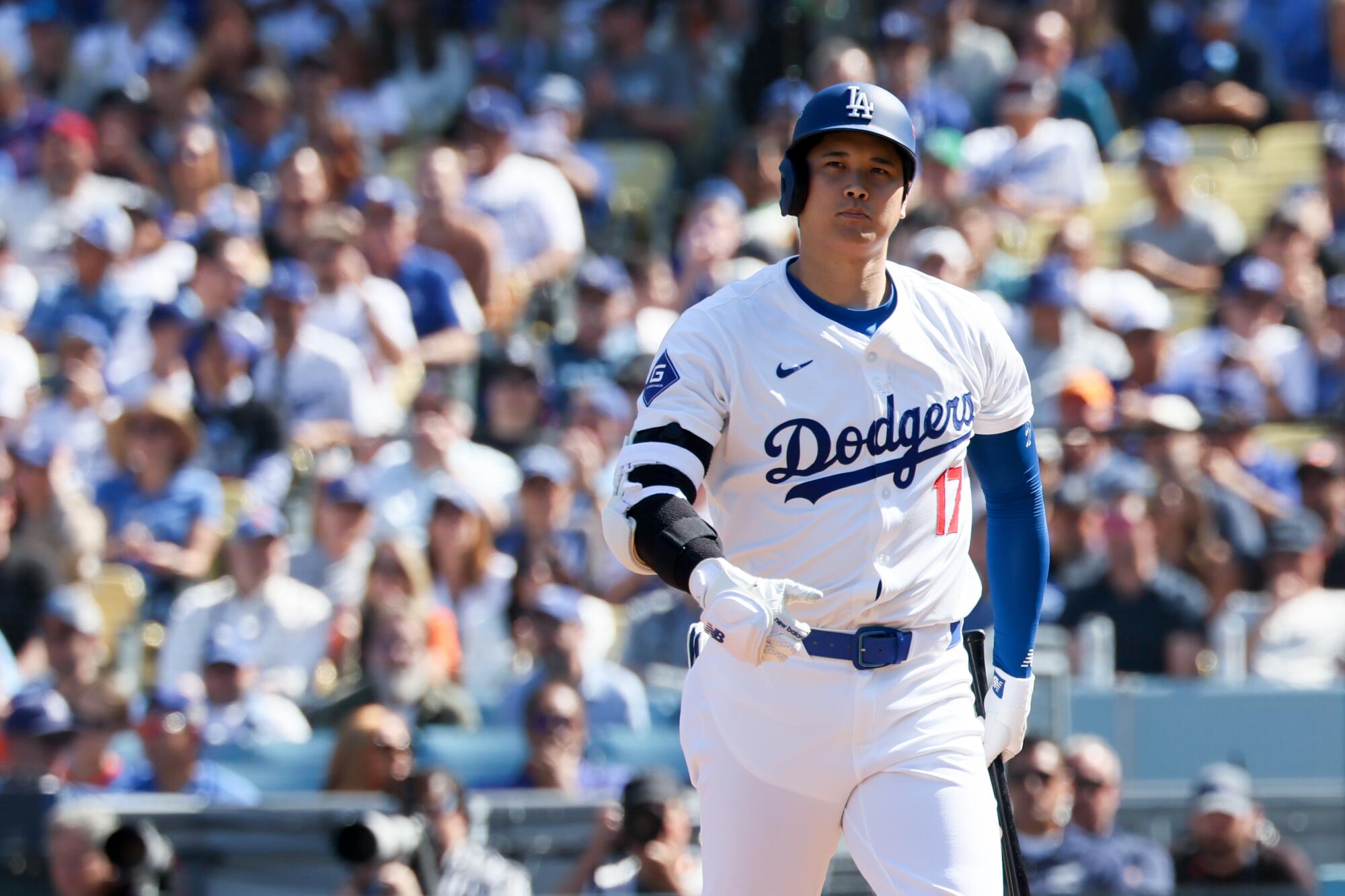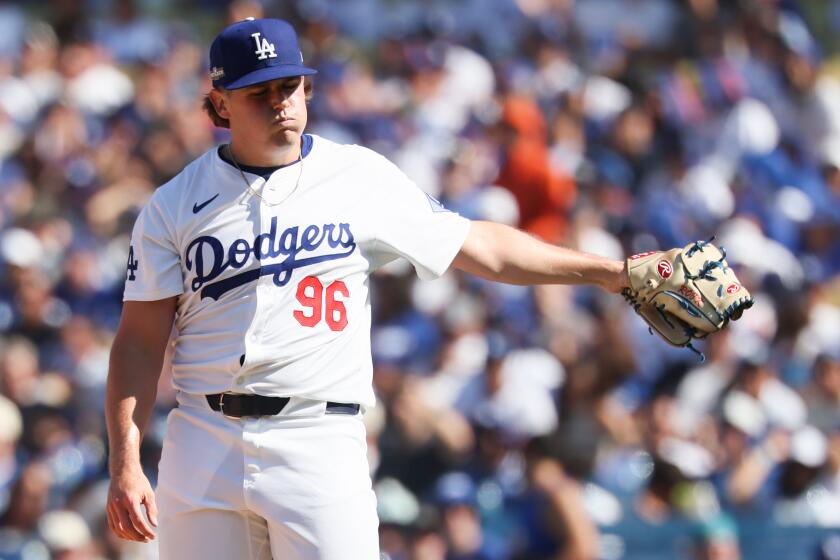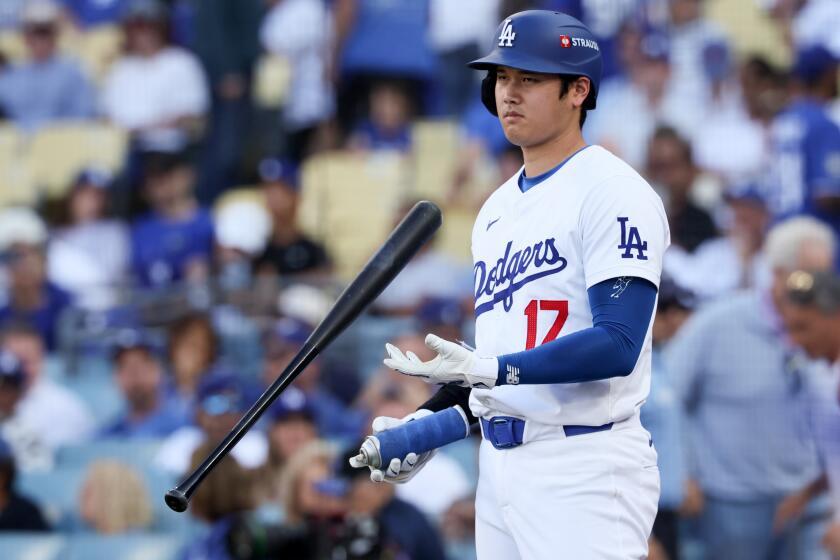
Shohei Ohtani was staring at his phone when I approached him in front of his locker in the wake of the Dodgers’ 7-3 defeat to the New York Mets on Monday in Game 2 of the National League Championship Series.
He glanced up.
We were alone, as the other reporters were in other parts of the clubhouse interviewing other players.
I figured readers of this publication would want to hear from their star after he was shut down in a defeat that leveled the best-of-seven series at one game apiece, but Oh-fer-tani was reluctant to speak.
“I don’t know what the other media will think,” he said in Japanese.
“It’s fine,” I assured him.
Mark Vientos hits a second-inning grand slam off Landon Knack, sending the New York Mets to a 7-3 win over the Dodgers in Game 2 of the NLCS.
Ohtani called over one of the team’s public relations managers, as if to ask him for permission to be interviewed. The official informed me that Ohtani wouldn’t be talking.
I said to Ohtani that I would like to hear that directly from him. Similar to any other player, Ohtani has the right to decline a postgame interview. Just because he doesn’t want to look uncooperative, he shouldn’t be passing that burden to a team official who in reality has no control over what he says or does.
Ohtani shrugged. He flashed that boyish smile that has made him the most endeared athlete in this market. He didn’t say anything and walked away.
Well, I suppose that’s better than him doing a Lincoln Riley and saying defensively, “There ain’t nobody taking more responsibility than I am,” but Ohtani sure made himself look coddled, didn’t he?
I’ve generally refrained from speaking to Ohtani outside of team-organized scrums, but Ohtani’s three at-bats against Mets starter Sean Manaea were arguably his three worst of the entire postseason:
A strikeout swinging in the first inning.
Another strikeout in the third, this one looking and on three pitches.
A weak pop-up to first base in the fifth.

It’s one thing to look confused against San Diego Padres starter Yu Davish, as Ohtani did in the NL Division Series. It’s another to be overpowered by Padres left-hander Tanner Scott, against whom Ohtani was 0 for four in the NLDS. It’s an entirely different thing to look completely helpless against Manaea, who doesn’t have Darvish’s variety of pitches or Scott’s high-90s fastball.
Ohtani appeared to never mentally recover from taking a couple of Manaea’s sweepers in his first at-bat. He started looking for the pitch in his second at-bat, which is probably why he struck out on three pitches, all of them hittable fastballs. By his third at-bat, Ohtani was desperate just to make contact and popped up a second-pitch sweeper to first base.
“I thought he didn’t look comfortable versus Manaea,” Dodgers manager Dave Roberts said.
Manaea departed from the game in the sixth inning, but the Mets continued to neutralize Ohtani by not pitching to him. Ohtani was walked in the seventh inning and again in the ninth.
With his three hitless at-bats, Ohtani is now 0 for 19 in the playoffs with the bases empty. He is six for eight with a runner or more on. Overall, he’s batting .222 in the postseason.

In Ohtani’s defense, pitchers are under less pressure to throw strikes when there isn’t any traffic on the bases. The opposing defense lines up differently too.
The numbers are the numbers, however, and Ohtani’s are unacceptable for a leadoff hitter. The role calls for him to reach base.
Nonetheless, Roberts said he wasn’t thinking of moving Ohtani down the order.
“I just don’t want to be too reactive,” Roberts said. “I just don’t see the benefit. We’ve got to just make sure that our guys are just swinging the bat well. And quite frankly, I want Shohei to get five at-bats a game. I think he’s our best hitter.”
Ohtani has to start playing like it again. He doesn’t necessarily have to hit for the Dodgers to win, but they’re certainly more likely to win when he hits. The Dodgers have won four games this postseason, and Ohtani has driven in runs in three of them.
The Dodgers entered NLCS Game 2 looking practically unbeatable, but the New York Mets buried any notion of an easy series for L.A. with their 7-3 victory.
The series will move from Dodger Stadium to Citi Field in New York for the next three games. The Mets will start a right-hander in Game 3 in Luis Severino, and that alone could again make Ohtani as dangerous as he was in Game 1 when he was two for four with two runs scored and another batted in.
Then again, if the Dodgers are to win the World Series, Ohtani at some point might have to hit a so-called Ohtani Stopper. He might have to reach base, not to drive in runs but to be in position to score them when Mookie Betts or Freddie Freeman or Teoscar Hernández are at the plate.
Because as Ohtani goes, the Dodgers go.
More to Read
Are you a true-blue fan?
Get our Dodgers Dugout newsletter for insights, news and much more.
You may occasionally receive promotional content from the Los Angeles Times.









